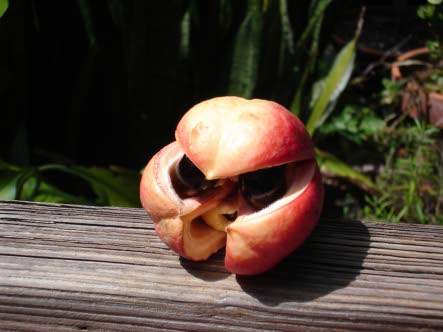


TSL Connect Vol. 14 Issue 2
TSL Connect Vol14 no2
TSL Connect Vol. 14 Issue 3
TSL Connect Vol14 no 3
Be careful of that unripe ackee
Be careful of that unripe ackee

MOST countries have a favourite or national dish. Popular with residents and forming part of a country’s identity, they are an important experience for visitors, too. Ackee, Jamaica’s national fruit, is not only a staple of the Jamaican diet, it is also socio-economically valuable, as its cultivation serves as a great employment opportunity for people in rural areas, where it is grown and processed.
The name “ackee” has African origins and is derived from the word “Ankye” from the Twi language of Ghana. Its botanical name pays tribute to Captain William Bligh, who brought the plants from Jamaica to England in 1793 and introduced it to the Western world.
Let’s give three cheers for the longest-married coupling, ackee and salt fish, a union which has been ranked by National Geographic among the top 10 national dishes of the world. Besides being delicious, it is very versatile and is now a favourite among vegan and raw food chefs who have created sumptuous versions of the fruit-such as ackee pizzas, wraps and also recipes where it can be seasoned and even eaten raw.
The Pan American Health Organization says that ackee is a good source of stearic, linoleic and palmitic acids. These fatty acids make up 55 percent of the total fatty acids in the ackee and provide a readily available source of fatty acids in the traditional Jamaican diet.
It has no saturated fat or cholesterol. A 3.5 oz serving of ackee weighs 100g and has 151 calories, with 9.5g of carbohydrates and a protein content that ranges from 2.9g to 8.9g, according to the University of Florida. The main vitamin in ackee is niacin, ranging from 1.1g to 3.9mg.
Ackee has 30mg of vitamin C and trace amounts of folacin, riboflavin, and thiamine. It contains 270mg of potassium, 98mg of phosphorus, 35 to 83mg of calcium, and up to 5mg of iron. It has 1mg of zinc along with 240mg of sodium.
A common misconception about ackee is that it contains a lot of cholesterol and unhealthy fats. Contrary to popular opinion there is no cholesterol at all in ackee, as this substance is found only in foods of animal origin; plants do not make this substance. And while ackee has a high concentration of fat, it is “good” fat.
Ackee is not just popular for its taste and usefulness in culinary creations, it has potential health benefits that may help with the following:
Digestive problems
The ackee fruit is rich in fibre, which can help regulate bowel elimination by adding bulk to your stool and quickening movement through your intestines. Fibre can also help lower your risk of bloating, cramping, constipation, and inflammation of the colon. It may also help reduce bad cholesterol levels, thereby helping boost heart health.
Blood pressure
Ackee is rich in potassium, which is a known vasodilator. It works by opening up (dilating) your blood vessels so that your cardiovascular system will not work too hard. This can help reduce the risk of atherosclerosis and damage to your blood vessels.
Blood circulation
Aside from helping lowering blood pressure, ackee can help improve your blood circulation. It is rich in iron, which is crucial because it helps deliver oxygen efficiently around your body. The iron content may help with the symptoms of anemia as well, such as weakness, light-headedness, and cognitive issues.
Be wise when purchasing ackees
When ripe, the fruit splits open to reveal three glossy black seeds or one large one surrounded by a thick, oily, yellow aril or flesh. The poison in ackee seeds and under-ripe arils causes vomiting followed by convulsions. The side effects can result in a coma and death. The PAHO states that the amino acids hypoglycin A and B cause the fruit to be toxic. The hypoglycin content diminishes after sunlight reaches the mature arils.
Both hypoglycin A and hypoglycin B are found in the seeds and the pinkish membrane at the base of the seed. The membrane, along with the seeds, is removed before preparing for cooking. The toxin is found in unripe fruits that are harvested too early and can have serious consequences for consumers as these are always poisonous. The fruit should be allowed to ripen and open naturally.
Many Jamaican children, in their innocence, have a tendency to eat unripened ackees because they are temptingly pretty to look at. Also, force-ripened ackees can sometimes be found in the markets, hence “Jamaican vomiting sickness’” is still relevant today. Consumers, therefore, need to be vigilant when they buy ackees that are in the pod. Look out for signs of forced opening.
The Hypoglycin content diminishes after sunlight reaches the mature inner flesh of the ackee. If the ackee is harvested at the right time the toxin level dissipates, making it safe for consumption. Potential risky behaviours for ackee poisoning include consumption of unripe ackee fruit, consumption of ackee that has been forcibly opened, and reuse of the water in which the unripe ackees have been cooked.
The different uses of ackee
Aside from being enjoyed for the various types of sumptuous dishes, other parts of the tree have various uses:
-
- Tools: In Ghana, the wood is used for making oars and casks.
- Perfumes: The flowers are used as an ingredient for perfumes.
- Medicines: Seed extracts and aril mixtures of the fruit have been used to help treat dysentery and kill parasites.
- Furniture: The wood is known to be termite-resistant, making it great for use as furniture.
- Gardening: The tree is a popular fixture in gardens because of its attractive characteristics.
Lastly, ackee plays an important role in the economy of Jamaica. The Jamaican ackee exporting industry is valued at around $4.5 million and is steadily growing every year. It helps provide many citizens with jobs. Liking for the dish Canned ackee is exported to meet demands of Jamaicans in the Diaspora, and a growing number of non-Jamaicans who have been introduced to ackee and salt fish have developed a liking for the dish.
Since when the product is improperly processed concentrations of toxins can pose a health risk, this concern about possible toxins in the fruit prohibited its importation into the United States from 1973, although Jamaica was exporting to various other countries around the world such as Japan, Central and South America, the United Kingdom, and Canada.
In issuing guidance on enforcement criteria for ackee, the FDA has instructed its district offices to detain, without physical examination, all ackee products offered for import. There are some exceptions: Firms that were identified on a “Green List” which, according to the FDA, have demonstrated that they have food safety controls in place to ensure that only properly ripened ackees are included in finished products.
The Jamaican firms are Ashman Food Products Ltd, Canco Limited, Central Food Packers Ltd, Double Deuce Jamaica Ltd, Exotic Products Jamaica Limited, Island Packers, Southern Fruits & Food Processors Ltd, GraceKennedy Limited, Stanmark Processors Company Limited, Tijule Company Ltd, and West Best Foods Limited.
In 1998 the Jamaica Exporters’ Association (JEA) was approached by the US Embassy in Jamaica to develop and implement a programme to get Jamaican ackees back into that market. This came out of a close working relationship with the US Department of Agriculture at the time, which translated into a personal interest of the then ambassador, Stanley McLelland, who hoped to make a transformational impact on the Jamaican economy. The JEA formed what was called the Jamaican Ackee Task Force — led by Director Dr. André Gordon, managing director of Technological Solutions Limited (TSL) — which spearheaded the process. TSL has the only laboratory in Jamaica accredited to test for ‘hypoglycin (the natural toxin found in ackee and which causes illness).
Some months later, in April 1999, at the request of the US Embassy in Jamaica, the FDA met with the US ambassador, the US Embassy’s agricultural attaché, representatives of the Bureau of Standards Jamaica (BSJ), the then JEA, and industry representatives to discuss the food safety issues relative to the fruit. The participants presented information on safe handling and processing practices to reduce the levels of toxin, and outlined a programme for ackee processors, with oversight by BSJ, to ensure that preventive controls were in place.
This was the start of an alliance between the US competent authorities (the FDA), the Jamaican competent authority (the BSJ), the ackee industry, and the exporters’ trade association (the JEA), which began as a simple outreach programme to develop a preventive controls programme to assure the safety of imported ackee into the United States.
Today, the FDA enjoys a robust working relationship with both competent authorities in Jamaica (the BSJ and the Ministry of Agriculture), as well as the ackee industry and the JEA – now merged as the Jamaica Manufacturers and Exporters and Association.
The goal of ensuring safe ackee products from Jamaica had been achieved.
Originally published by The Jamaica Observer https://bit.ly/2Kbofe1
Dr. Wendy-Gaye Thomas is group technical manager, Technological Solutions Limited. Contact her at wendy .thomas@tsltech.com
Prospects For Export-Led Growth In Jamaica
Prospects For Export-Led Growth In Jamaica
Jamaica’s historical economic performance and current reality indicate that all other things considered, the only lever we have to drive significant and sustained increases in growth above the anaemic 1% to 2% that we have managed, at best, over the last two decades is through increases in our net exports.
As a country, we need to decide whether achieving sustained export-led growth is important. If so, we need to ask where it falls within our national priorities. Is a focus on export-led growth even mentioned within our national growth strategy as a major
driver? Or is the strategy only focused on driving foreign direct investments (FDI), growing our hotel room numbers, building out the Special Economic Zones (SEZs), the JISCO investment in St Elizabeth and BPOs?
Over the last 15 years, Jamaica had high levels of FDI of US$867m, US$1,440m, and US$925m in 2007, 2008, and 2015, respectively. GDP growth in these years was 1.4%, -0.8%, and 1.0%, respectively.
In 2016 and 2017, FDI was US$928m and US$888m, with growth rates of 1.5% and 0.5%, respectively. In other words, the highest levels of FDI that we have had in the recent past did not result in significantly enhanced growth, with the positive correlation between GDP growth and FDI being very weak.
Our history has shown us, therefore, that while important, these investments and projects are unlikely to significantly alter our growth trajectory without also having a significant export component, accompanied by deep linkages to the domestic economy.
We hear talk about agriculture and the importance of agriculture. Where is the comprehensive modern, forward-looking agricultural development plan? If we take out the oil-import component from our trade deficit, would the deficit still be as significant? Why do we have such a massive trade deficit that continues to rise? How do we intend to finance our economy going forward? More borrowings? More taxes? Is that not what all governments have done, certainly for the last 30 years or so? What has been the outcome?
This is the real crux of our economic challenge, and even a cursory analysis would suggest that export-led growth should be the major thrust of our entire economic programme. But is it?
Since the Seaga administration in the 1980s, no government has had a specific, focused, targeted policy and supporting programmes as well as the attendant budgetary allocations to grow our exports. The Government in the 1990s undertook an extensive process to develop a national industrial policy (NIP) in which many of us we’re involved. This was a very hopeful time, as the process was led by the minister of finance at the time, Hugh Small, and had an excellent team of technocrats, including Professor Donald Harris, who did exceptional work on defining the options for our exports and elements of an export strategy. His work clearly showed the economic benefits that we would derive from shifting our focus to export-led growth. Unfortunately, this did not materialise’
We have subsequently had the National Export Strategy (NES), which was launched in 2009 and which was developed through public-private-sector partnership led jointly by JAMPRO and the JEA. It had some success, but failed to achieve its goals, largely because of under-resourcing by successive Governments. The second version of the strategy, NES 2015-2019, was launched in 2015.
One of the overarching goals of the NES 2015-2019 is to grow exports at an average of 15% per annum to bring export levels (dollar value) to the pre-recession level of 2008-2009 (i.e., US$5.2 billion). At the targeted rate, export of goods should have got back to US$2.3b by this year. Clearly, this has not happened. Again, this is largely because of a lack of focus on it by the government and inadequate provision of resources to JAMPRO and the JEA to make it a reality.
EXPORT GROWTH PROSPECTS
We have looked at the issues that have led us to where we are, but what about the prospects for us to do better? There are several fairly immediate approaches that can lead to a near-term change in our export trajectory, many of which have been presented to successive governments before.
Beverages, seafood, baked goods, yam, and selected agricultural produce and sauces are among the products that have led the consistent growth of the food component of our non-traditional exports even while other exports were declining. In fact, some categories have increased by well over 50 per cent over the last five years. Nevertheless, while this might sound good, how does it compare with other exporters in the region and globally?
In the area of sauces, Guyana has doubled their sauce exports in the last three years, Barbados gets up to US$1 on average more per unit than we do, and the Dominican Republic (DR) exported US$92m in 2016, while we do a meagre US$19.2m by comparison.
Beverages in the categories that we export are growing at well over 30% per annum, with exports from Barbados and the DR growing at between 45% and 80% over the last several years, and, for countries like Zambia and Tanzania, growing at 130% and 380% in 2014, respectively. Our baked goods (cakes, buns, biscuits, etc.) are also showing consistent growth and can grow at much faster rates as also are our seafood exports, driven by the performance of firms such as Rainforest Seafoods, B&D Trawling, and others. In general, then, we can do much better than we are doing at the moment.
EXERCISING OUR OPTIONS
While we have shown consistent improvement in some areas, what is required is a coherent, comprehensive programme like that outlined in the NES, implemented in a disciplined manner to meet the targets we have set. This could build on the platform that has been set for us to really produce moderate to high sustainable economic growth by the decades of sacrifices that Jamaican people have made to get to where our national finances are today.
However, this will only happen if we have the right strategies, chosen on the basis of empirical evidence and facts, and supported with appropriate human and financial resources. In other words, unless the NES and other accompanying export-driven programmes are provided with the resources needed and made a national priority, we will continue to suffer in vain.
We have real possibilities for significantly expanding export-linked manufacturing [AG1] and agriculture. This could also include the new cannabis industries. We also have significant opportunities to grow our service exports. Have we benefited from having Usain Bolt, Veronica Campbell Brown, and other athletes being known all over the world? Have we formed strategic alliances with our musicians for our mutual benefit, Bob Marley and other music pioneers having given Jamaica a gift horse in our music?
These are all areas in which we have significant advantages and in which we can derive near-term success. From these and other targeted sectors mentioned above, as well as others outlined in the NES, we can get quick, sustained, and mutually growth-reinforcing wins.
It is clear, therefore, that Jamaica has numerous opportunities and avenues through which we can achieve real sustainable economic growth and positively impact our current social circumstances. All of these approaches, programmes, and opportunities remain available to us. It is for us to make use of them and have them impact our future in a more meaningful way. We now need to move from talk to action.
As citizens of Jamaica who have sacrificed much, we must stop accepting the blandishment and empty speeches from our political leaders of whatever stripe and demand hard answers, backed by evidence of seriousness. We must demand performance, not platitudes. We must demand that we get firm, measurable outputs from carefully developed programmes and demand that they are properly funded. This is the only way we can evaluate, and, if required, hold the persons responsible for failing us in their stewardship of our collective future.
Gone must be the day where we accept non-performance and mediocrity as the norm and accept PR as a substitute for real tangible performance. This has led us over many years to where we are! We need to demand
that creating and facilitating a significant and sustained expansion in net exports becomes a central strategy of the current and all future governments’ economic programme.
Only then will we begin to see the creation of a virtuous cycle of positively reinforcing economic activities and fulfil the duty of our generation: to leave an economically strong, growing, truly independent Jamaica that is the place of choice to live and do business, for the benefit of all Jamaicans.

